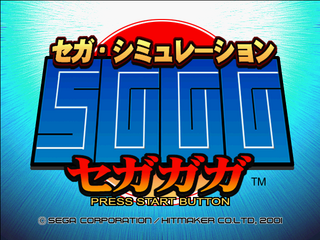Segagaga
From Sega Retro
This teeny-tiny article needs some work. You can help us by expanding it.
| Segagaga | |||||
|---|---|---|---|---|---|
| System(s): Dreamcast | |||||
| Publisher: Sega | |||||
| Developer: Hitmaker | |||||
| Genre: RPG | |||||
| Number of players: 1 | |||||
|
Segagaga (セガガガ) (or SGGG) is a Sega Dreamcast RPG developed by Hitmaker and published by Sega in 2001.
Though not quite released at the end of the system's lifespan, Segagaga is often considered to be the swan song of the Dreamcast, being an RPG that satirises Sega's then-current position in the video game marketplace as well as playing homage to the company's achievements over the last twenty years before this game was released.
The game is set in 2025, with Sega commanding just 3% of the home console market and their last project making little impact. Out of desperation, the "Segagaga project" is initiated, in which two young children are to pull Sega from the brink of destruction and gain complete control of the market, currently owned by the evil DOGMA Corporation. In reality, it was the Dreamcast in 2001 struggling to maintain a sizable share of the market, as rivals Sony made gains with their PlayStation 2 console.
Many Sonic Team properties show up in cameos within the game. As well making brief appearances in the intro sequence and created software within the game, items such as the "Piko Hammer" are available. Also, characters such as Nei (from Phantasy Star), Ristar, NiGHTS and Sonic the Hedgehog can be recruited as programmers for your team.
Development
Segagaga was the brainchild of Tez Okano, however when the concept was first brought to the management of Sega, it was misinterpreted as a joke and a potential risk to the company's image. A second attempt at acquiring funding caught the attention of Hisao Oguchi, and a development budget was granted.
Segagaga took over two years to develop, but was kept a secret until near release. By this point, Sega's management were willing to try anything that could save the company from further losses, and so the game was released in March of 2001. Nevertheless, Segagaga's release was kept very low-key, and for the first two months was only available via Sega's Sega Direct service. Strong online sales caused the game to be shipped to stores, before receving a Dorikore re-release two years later.
The game features a number of Sega franchises and references dating back to the likes of the SG-1000, although several legal challenges occurred during production. It is said that out of the 300-or-so issues that could have caused legal concerns, only a third were actually addressed by the team. Some planned features, like references to Ferrari vehicles (OutRun) and Segata Sanshiro were scrapped entirely through fears of legal challenges, however features many were not. For example, the game has a number of "parody games" hidden inside it, which poke fun at various big intellectual properties from Final Fantasy to Mega Man.
The game reportedly had one-hundredth of the budget backing Shenmue. Toei Animation gave him a discount on animated footage. Tez Okano also marketed the game himself with a budget of roughly $200 USD, half of which he spent on a wrestling mask to hide his identity. Okano set up four signing locations in Akihabara and rewarded Sega fans which were to all four. He was assisted by Tadashi Takezaki and Taku Sasahara and led to a full page newspaper spread.
The music for the final boss is "The Justice Ray Part 3," written by Tecnosoft composer Hyakutarou Tsukumo for the ultimately-cancelled Thunder Force VI (though wound up making it to the preemptively released "Broken Thunder" soundtrack album). "The Justice Ray Part 1" had appeared in Blast Wind and Part 2 in Thunder Force V.






